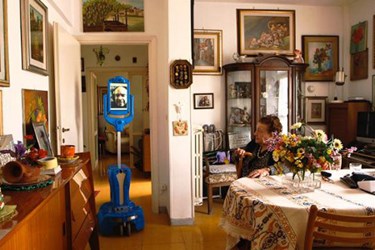Will Robots Provide Care For The Elderly?
By Joel Lindsey

A team of researchers in Europe has developed a system of in-home care for the elderly that combines a telepresence robot, a network of sensors, and videoconferencing technology. The goal is to make it safer and more feasible for people to live independently at home as they grow older.
“Today there are an estimated 5 million homes in the EU where elderly residents are receiving formal care services, and 12 million homes globally,” Stephen Von Rump, CEO of Giraff Technologies AB, the company developing the system, said in a press release published recently on the EU’s Community Research and Development Information Service website. “Those numbers would more than double if one includes elderly who don’t receive formal care, but who (or whose families) would gladly pay for a telecare service if it would extend their time living at home.”
The new system, called GiraffPlus, centers around the telepresence robot, which is designed to move around the home of elderly residents. The robot also comes equipped with a Skype- or FaceTime-like device that allows residents to videoconference with friends, family, and healthcare providers.
In addition to the GiraffPlus robot, the system uses a network of sensors that have been positioned throughout the home and on wearable devices worn by the resident. These sensors track the resident’s movements throughout the house, detect any falls or injuries they may sustain, and monitors certain vital signs like blood pressure and body temperature.
Researchers claim that GiraffPlus’ combination of devices and sensors could allow elderly residents to remain in their homes while still having a way to contact medical authorities if an emergency arises.
“Different services, depending on the individual’s needs, can be pre-selected and tailored to the requirements of both the older adults and healthcare professionals,” according to the GiraffPlus product website. “Special emphasis in the project is given to evaluations and input from the users so that the system can have an empathetic user interaction and address the actual needs and capabilities of the users.”
So far, GiraffPlus systems have been installed in six homes in Europe. The team of researchers developing the system plans to install it in 15 homes by the end of 2014, and hopes to make it commercially available sometime next year.
“We are currently in the middle of the evaluations, but we see that various aspects of the system are appreciated differently by the different users,” said Amy Loutfi, GiraffPlus project manager. “This goes to show that there is no ‘one-size fits all’ approach to technology at home, and that the latter should be both adaptable and tailored to users’ needs.”
Other efforts have been made recently to use various types of sensors and communications devices to provide better in-home care for the elderly. A group of researchers at Villanova University have recently developed a system that uses radar to detect when an elderly resident falls down or becomes injured, according to a story published by Med Device Online.
Image credit: Giraff Technologies
